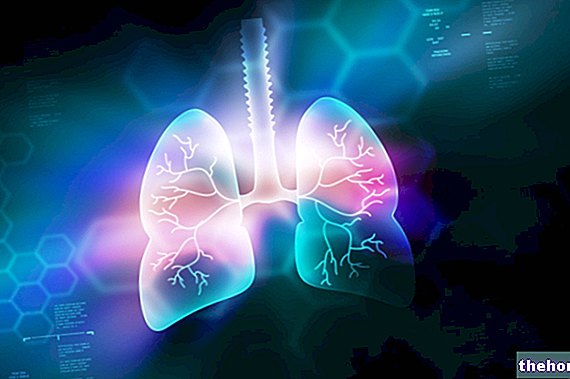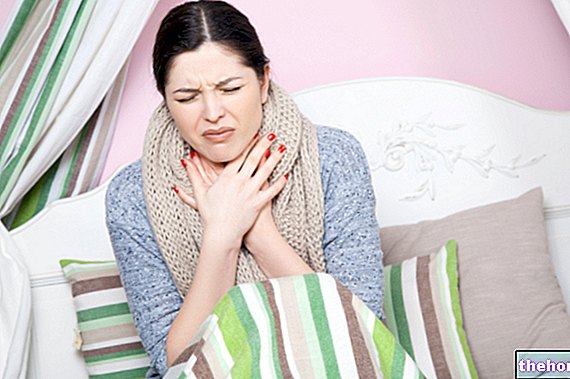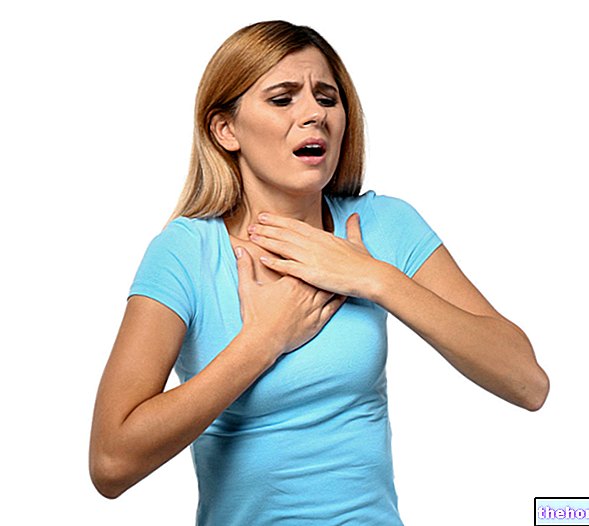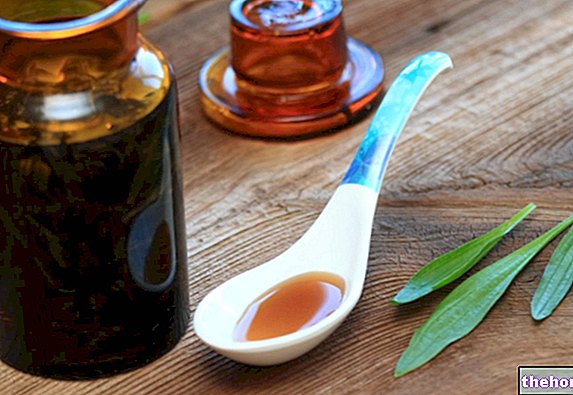Epistaxis and rhinorrhagia are the scientific names for a symptom / disorder commonly known as a nosebleed.
Epistaxis can be:
- Primary / essential or idiopathic, i.e. without an obvious cause
- Secondary (especially in the elderly), when it represents a specific pathological symptom of a local or general (even serious) problem.

The main reasons are physical stress (trauma, awkward finger maneuvers) and hormonal changes during growth.
Some causes of secondary nosebleeds are:
- Local: varices of the septum, nasal polyps, deviations of the septum, neoplasms, perforating ulcer of the septum, Rendu-Osler's disease, nasopharyngeal fibroma, chemical irritation from volatile substances or from the use of cocaine, infection (bacterial, viral or fungal rhinitis).
- General: vascular fragility, arteriosclerosis, heart disease, hypertension, infectious diseases (scarlet fever, typhoid fever, measles, etc.), poisoning, coagulopathies, vitamin deficiencies, kidney and hepatobiliary diseases, heat stroke.
The material published is intended to allow quick access to advice, suggestions and general remedies that doctors and textbooks usually dispense for the treatment of Epistaxis; these indications must in no way replace the opinion of the treating physician or other healthcare specialists in the field who are treating the patient.
What to do
- Depending on the triggering cause, nosebleeds can be prevented more or less effectively (see Prevention below).
- Treat or compensate for diseases that cause nose bleeding (dysplasias, ulcers, deviations, varices of the nose; atherosclerosis, heart disease, hypertension, infections, coagulopathies, kidney and liver diseases).
- Follow a balanced diet.
- During the bleeding episode, the most useful measures to stop the bleeding are:
- IF there is no head injury:
- Get into a sitting position and tilt your head slightly forward.
- Spit up the blood to avoid the onset of nausea and vomiting.
- Free the neck: loosen the tie, undo the shirt, take off the scarf or foulard.
- Apply pressure to the bleeding nostril for a few minutes.
- Apply a cold woolen cloth, preferably containing ice, directly on the nose: the low temperature causes vasoconstriction and the consequent decrease in blood flow. Alternatively, you can wet it with cold water.
- IF the nosebleed continues:
- Contact a doctor or paramedic (emergency room) for:
- Application of a tampon (cotton or gauze with hydrogen peroxide).
- Nasal cauterization.
- IF the subject loses consciousness, it is best to place him lying on his side (especially with the suspicion of a head injury).
What NOT to do
- Neglecting the primary diseases responsible for nosebleeds.
- Avoid exposure to volatile chemicals. Examples are: thinners, paints, paint stripper, etc.
- Avoid using cocaine or other inhaled drugs.
- Avoid the abuse of drugs that dry the mucosa excessively or weaken it: antihistamines for allergies, anti-congestants such as naphazoline (for example Rinazina ®), cortisone drugs, etc.
- Avoid the risk of heatstroke, often responsible for nose bleeding.
- During the epistaxis:
- Avoid anxious states and physical agitation: both emotional complications and cardio-respiratory hyperactivation are capable of worsening the epistaxis.
- Avoid positioning the head backwards: it can favor the ingestion of the blood that descends from the palate and accumulates in the oral cavity (favoring the onset of nausea and vomiting).
- IF the nose is swollen and painful, suggesting a craniofacial trauma with fracture, AVOID any intervention and go directly to the emergency room.
What to eat
- There is no diet that can prevent nose bleeding. However, it is possible to define a diet rich in vitamins as a preventive factor.
- Vegetables rich in protective vessel substances: they are triterpenes, tannins, pigments, etc. They have an antioxidant and enhancing function of collagen synthesis. The foods that contain them are all those of vegetable origin: fruit, vegetables, seeds, roots, flowers, black wine, etc. To preserve their function they must be fresh.
- In case of hypertension, the diet should be aimed at reducing this primary disorder (see Hypertension Remedies).
- If the rhinorrhagia is severe and contributes to establishing an anemic picture, it is essential to compensate for the losses by eating foods rich in bioavailable iron, vitamin B12, folic acid and vitamin C:
- Foods rich in iron, especially heme and ferrous (2+):
- Muscle tissue: both of terrestrial and aquatic animals: horse, bovine, swine, avian, fish, whole molluscs (including land snails), whole crustaceans, etc.
- Eggs: any, especially the yolk.
- Offal and fifth quarter: especially spleen and liver, but also marrow, diaphragm, heart, etc.
- Foods rich in vitamin C, citric acid and fructose:
- Sweet and sour fruit: lemon, grapefruit, orange, mandarin, clementine, kiwi, cherries, strawberries etc.
- Vegetables and tubers: parsley, pepper, lettuce, spinach, radicchio, broccoli, tomato, potato, etc.
- Foods rich in vitamin B12 (cobalamin):
- The same foods as a source of heme iron; in addition, certain algae and bacteria are rich in vitamin B12.
- Foods rich in folic acid: liver, vegetables (e.g. tomatoes), sweet fruits (orange, apple, etc.) and legumes (e.g. beans).
- NB: Vitamin C or ascorbic acid and folic acid are thermolabile molecules and degrade with cooking. This means that the foods that contain them must be eaten mostly raw.
- However, the anti-nutritional principles (phytates and oxalates) are degraded with heat treatment. This means that legumes, whole grains, spinach, rhubarb etc. should always be consumed after cooking.
What NOT to Eat
- There are no foods that worsen nose bleeding, with the exception of alcohol and chilli, which have a strong vessel dilating effect.
Natural Cures and Remedies
- Herbal medicine. It is based on vegetables rich in tannins, triterpenes, flavonoids in general and vitamin C. They optimize collagen synthesis by strengthening the vessels and act as powerful antioxidants:
- Shepherd's purse.
- Bistorta.
- Consolidate.
- Oak mistletoe.
- Nettle.
- Horsetail.
- Tormentilla.
- Idraste.
- Witch hazel.
- Gotu kola.
- Ivy.
- Hesperidin.
- Diosmin.
- Horse chestnut.
- Rusco.
- Rutina.
- Escin.
- Blueberry.
- Red grapevine.
- Vitamin C food supplements: optimize collagen synthesis.
- Supplements based on arginine: essential amino acid precursor of nitric oxide, a compound essential for the elasticity of the vessels.
Pharmacological treatment
- Ointment based on Witch Hazel (plant): it is indicated in the therapy of epistaxis, but it is not a real drug
- Tranexamic acid, for example Ugurol® and Tranex®: are anti-haemorrhagic drugs that facilitate clotting and reduce nosebleeds. They are used only in cases where the rhinorrhage is very severe and associated with the general bleeding tendency.
Prevention
The preventive measures against rhinorrhagia are generic and mainly concern cases of primary epistaxis:
- Avoid pressure changes: a striking example is that of the fleeting ascent of a scuba diver. On the other hand, such conduct could lead to far more serious complications than a banal nose bleed (see Decompression Sickness - DCS).
- Keep track of any diseases that cause nosebleeds and avoid relapses; especially colds, allergic rhinitis, flu and in general all diseases affecting the nose. They cause inflammation / hypertrophy of the mucous membranes and their irritation, resulting from repeatedly blowing the nose.
- Do not expose the nasal mucosa to volatile irritants.
- Do not use nasal medications unnecessarily.
- Do not expose the nasal mucosa to physical stress.
- Preventing heat exhaustion.
- Follow a balanced diet rich in vitamins and other nutritional elements that can improve the condition of the vessels.
Medical Treatments
- Application of a cotton swab or hydrophobic gauze inside the nostril: This is an operation that should be performed by medical or paramedical personnel. However, if the nosebleed is not complicated by bone fractures, mucosal lacerations and loss of knowledge, it is possible to carry out the maneuver autonomously.
- Nasal cauterization or electroplating: burning of the mucous membrane in which the vessel has ruptured. It serves to heal the lesion by stopping the bleeding. Must be performed by medical personnel.
- Ligation: consists of manual locking of the damaged vessel with a wire.




























